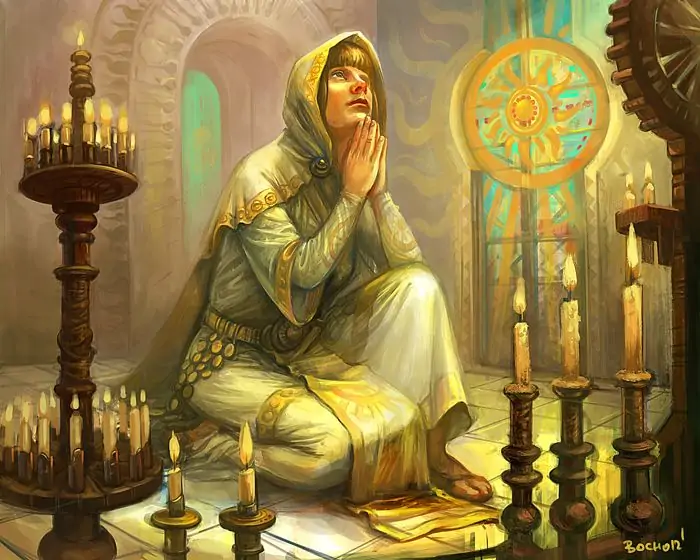When people talk about Ceremonies, they think of weddings, funerals, and other things. Of course, when we come to a D&D perspective, it would generally be the same until the addition of the Ceremony spell in Xanathar’s Guide to Everything. From that point on, the term became a spell, and the spell became a debate topic on how to break it.
Given that the spell is new, it comes to the D&D veterans to come up with both the problem and solution on this versatile spell. The problem I have encountered is how to best use this spell to maximize its efficiency and usage. The key, after much consultation, will come in the following few segments.
So from Exandria to the Forgotten Realms, join me as we look at what ceremony can do and how to ensure that this D&D spell is used to maximum effect. Let’s kick off our Ceremony 5e guide by looking at what exactly this spell is. Welcome to a Ceremony 5e Guide.
What is Ceremony
| Casting Time | 1 Hour (Ritual) |
| Range | Touch |
| Target | 1 target |
| Components | V.S.M.(25 Gp worth of Powdered silver that is consumed) |
| Duration | Instantaneous |
You perform one of several religious ceremonies. When you cast the spell, choose one of the following ceremonies, the target of which must be within 10 feet of you throughout the casting.
Ceremony is a 1st level spell with the following options on which singular effect activates.
- Atonement
- Bless Water
- Coming of Age
- Dedication
- Funeral Rite
- Wedding
Introduced in Xanathar’s Guide to Everything, it is one of the wordiest spells for 1st level spell slots. Each ceremony has a different effect. Generally, they do not have combat effects, and none have any permanent stat bonuses. It does provide a lot of short-term utility and roleplaying purposes.
In detail
Casters can cast Ritual Spells without consuming a spell slot; they add 10 minutes to the casting time. It still consumes the material component, but at least the spell slot was not used. Assuming you cast it, you need to declare at the start of the cast what effect you are going for. Here is what they do.
Atonement
The Ceremony of Atonement is to revert a character to its original alignment. It quotes, “You touch one willing creature whose alignment has changed, and you make a DC 20 Wisdom (Insight) check. On a successful check, you restore the target to its original alignment. “
These are for people who have fallen off the right path or creatures that seem redeemable. A recent example of how to use it was in the Exandria Unlimited: Calamity campaign.
The target must be willing, and the caster must make an insight check. Otherwise, the ceremony will fail, so be sure that the creature you are casting this on is genuinely willing to return to how they were.
Bless Water

“Touch one vial of water and cause it to become holy water.” given that this spell costs 25GP to cast, there was debate over whether this wording was an error or entirely intended. The factor that was arguing point was that it creates one Vial of holy water.
If we look at holy water in the PHB on page 152. “As an action, you can splash the contents of this flask onto a creature within 5 feet of you or throw it up to 20 feet, shattering it on impact. In either case, make a ranged attack against a target creature, treating the holy water as an improvised weapon. If the target is a fiend or undead, it takes 2d6 radiant damage. A cleric or paladin may create holy water by performing a special ritual. The ritual takes 1 hour to perform, uses 25 GP worth of powdered silver, and requires the caster to expend a 1st level spell slot.”
So taking this into account, it is practically the same to cast Ceremony and to use the holy water ritual. So what is the difference, you may ask? Well, with Ceremony, you can save on one spell slot. Also, you do not need to be a cleric or a paladin to cast it if you learn it through other means.
It also creates vials of holy water that do not expire, so if you do not mind paying the 25gp each time in a pinch, you can make these if there is no temple to purchase them from.
Coming of Age

“You touch one humanoid who is a young adult. For the next 24 hours, whenever the target makes an ability check, it can roll a d4 and add the number rolled to the ability check. A creature can benefit from this rite only once.”
A bonus to ability checks is always nice, especially if this precedes some kind of rite of passage. Ability checks are the general roll that happens outside of combat so that one use of a D4 could end up changing an outcome that seemed impossible.
The age is a little relative since “young adult” changes when you look at long-lived races versus extremely short-lived ones. Aside from that, Ceremony is as straight as it seems.
Dedication
“You touch one humanoid who wishes to be dedicated to your god’s service. For the next 24 hours, whenever the target makes a saving throw, it can roll a d4 and add the number rolled to the save. A creature can benefit from this rite only once.”
It is an interesting ceremony that can basically kickstart a character’s journey into becoming an adventurer. It could turn into a backstory for a paladin or cleric in training as they dedicate themselves to the faith. With tons of gods in the Forgotten Realms, there are many ways to spin this. You can create a story where cultists induct harmless villagers to their evil god or make this a rite of passage for any would-be paladins.
Funeral Rite

“You touch one corpse, and for the next seven days, the target can’t become undead by any means short of a wish spell.”
This is especially effective in campaigns themed around undead or if your evil final boss is a lich or necromancer. I remember using this in the Curse of Strahd campaign remake. My paladin was paranoid that Strahd could create the undead behind us. Thankfully they remained buried for the rest of the campaign.
It can also serve as a way to both appease villagers or other NPCs you meet on your journey and a warning sign if undead does decide to show up. It shows that the enemy can cast the reality-warping Wish spell.
Wedding
“You touch Adult humanoids willing to be bonded together in marriage. For the next seven days, each target gains a +2 bonus to AC while they are within 30 feet of each other. A creature can benefit from this rite again only if widowed.”
The last ceremony on this list is one that has a semi-permanent stat buff. Sure it only lasts a week, but for 25gp, that could come in clutch when a crucial moment arrives. Pair that with the literal happiness of marriage, and you end up with a very happy character.
It’s nice; it’s touching, and it’s the most powerful effect among all of them. As they say, Love Conquers All.
What Classes can cast this
Ceremony is a 1st level abjuration spell, but it also falls under the Divine type of magic. Magic of the gods and other deities. So when it comes to who can cast it, then it makes sense that the classes closest to priests in real life are the ones who are able.
Cleric

The most priestly of classes, all clerics have access to this spell. No longer do we have to ask the DM if we can make an impromptu ceremony when this spell came about. Armed with this, your cleric can pray for those in need or give a blessing to chosen NPCs or trainees of the cloth.
That does not mean that only clerics can hold ceremonies, but rather clerics with class levels can conduct ceremonies that empower others. They also have access to the Ritual casting class ability, so they can do these ceremonies with no spell slot consumption, which is a great boon when it comes to long marching days.
Paladin
Closer to crusaders than priests, these guys also have access to this spell. Unlike clerics, paladins do not have access to the ritual casting class feature, which means that each time they cast this spell, it does take up a spell slot.
It makes sense since they also devote their time mastering their martial skills that their spellcasting is not as proficient as a cleric’s. Still, the effects of the spell remain, as having a ceremony upheld by a heroic figure is sure to inspire those partaking in it.
Sorcerer (Divine Soul)
Ok, so hear me out before you voice your disagreements. Divine Soul sorcerers are allowed to learn any Divine spell from the cleric list whenever they level up and are allowed to learn more spells. That means that if they wanted to, they could take the Ceremony spell at level 1
Sorcerers are weird in the sense that their magic is naturally gifted to them from their bloodline. For Divine Souls, they might have angel blood running through them, or they were blessed as a baby, perhaps even chosen by a god for a divine purpose. No matter the case, they can cast Divine spells as if they were sorcery and even gain access to their subclass features at level 1. (to further emphasize that they were born with it).
Bard (technically)

Lastly, bards, Technically, every bard can learn almost any spell using their Magical Secrets class ability at level 10. So long as they can cast the level of the spell, they can learn two spells from other classes. It would be rare to see a bard with Ceremony as they can learn much stronger spells, but hypothetically it is completely legal to learn it.
It would be funny to have a ceremony done by a musician that ends up giving the same boons as a holy figure or a saint. Just food for thought for fellow DMs.
Combos
The most known combo is the Wedding permanent buff. To do so, be sure that everyone in your party is ok with a shotgun marriage, then have a Zealot Barbarian in your party. Once both conditions are fulfilled, marry your entire party together. Wedding does not have a limit on how many people can get married to each other, so having this massive seven-way marriage is completely in the rules. Then at the end of every week, murder your Zealot Barbarian and bring them back to life.
What makes this work is multiple things; Zealot Barbarians can be resurrected for free using their Warrior of the Gods subclass ability. Wedding only lasts one week but can be recast once the wed are widowers. Following that, you can cast Ceremony as many times as you want since it is a ritual spell. So on paper, your entire party gets that +2 to AC so long as they are within 30ft of each other.
Another combo also involves a wedding. You wed a target and assume you’ve managed to convince them to accept. You cast Imprisonment on them. As messed up as it sounds, if you marry a villager, they have 5 HP, meaning once your week honeymoon has expired, you can kill the villager and recast it on a new target. I heavily do not support doing this as it is an easy way to both gain a bad reputation and get smote by your DM.
This last combo also requires your DMs approval. It also varies depending on the campaign setting. Basically, if your DM does not sell holy water at the base price, then this is viable. Assuming that holy water is more than the listed amount in the DMG, you can create vials of holy water and sell them for more than 25GP.
It messes with the economy and may cause problems down the line, but if you are looking for a quick profit, then this is one of the best ways to market it. It is doubly effective in locations with no access but has a high demand for the stuff.
FAQ
Question: Is Ceremony a ritual?
Answer: Yes, it is. It has the ritual tag and takes an hour to cast. So in both senses of the question, Ceremony is a ritual.
Question: How does Ceremony work exactly?
Answer: Upon casting the spell, you have to choose which ceremony you are enacting. Then after an hour, the spell completes, and the effect is granted.
Question: How can I marry in D&D?
Answer: You need to have someone officiate a wedding for you. While yes, you can have a fellow cleric or paladin cast a Ceremony on you and your spouse, it is not necessary for a leveled character to marry two people in D&D.
Ceremony 5e Guide: Final Remarks
While in the beginning, this spell was received rather poorly, as its effects were mediocre at best. It slowly gained notice as people began to find uses for those “mediocre” effects. After that, it rose in popularity as something that could be used to complete specific builds.
Now it rests as a spell that people take for RP purposes or they take whenever they know the other party members beforehand. I would rate it a 7/10 when it comes to efficiency.
- Prestige Classes 5e Guide - September 20, 2022
- Rod of the Pact Keeper 5e Guide - September 15, 2022
- Sanctuary 5e Guide - September 14, 2022


